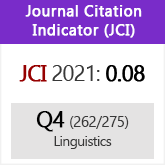Sets, rules and natural classes: [ ] vs. { }
DOI:
https://doi.org/10.3989/loquens.2019.065Keywords:
phonology, features, set theory, logic, unification, phonological rulesAbstract
We discuss a set-theoretic treatment of segments as sets of valued features and of natural classes as intensionally defined sets of sets of valued features. In this system, the empty set { } corresponds to a completely underspecified segment, and the natural class [ ] corresponds to the set of all segments, making a feature ± Segment unnecessary. We use unification, a partial operation on sets, to implement feature-filling processes, and we combine unification with set subtraction to implement feature-changing processes. We show how unification creates the illusion of targeting only underspecified segments, and we explore the possibility that only unification rules whose structural changes involve a single feature are UG-compatible. We show that no such Singleton Set Restriction can work with rules based on set subtraction. The system is illustrated using toy vowel harmony systems and a treatment of compensatory lengthening as total assimilation.
Downloads
References
Bale, A., Papillon, A., & Reiss, Ch. (2014). Targeting underspecified segments: A formal analysis of feature changing and feature filling rules. Lingua, 148, 240-253. https://doi.org/10.1016/j.lingua.2014.05.015
Bale, A., & Reiss, Ch. (2018). Phonology: A Formal Introduction. Cambridge, MA: MIT Press.
Bendjaballah, S., & Haiden, M. (2008). A typology of emptiness in templates. In J. Hartmann, V. Hegedus, & H. van Riemsdijk (Eds.) Sounds of Silence: Empty Elements in Syntax and Phonology (pp. 23-59). Amsterdam: Elsevier.
Borrelli, D. A. (2013). Raddoppiamento Sintattico in Italian. A Synchronic and Diachronic Cross-dialectical Study. New York: Routledge. https://doi.org/10.4324/9781315024219
Chomsky, N. (2000). Language as a natural object. In New Horizons in the Study of Language and Mind (pp. 106-133). Cambridge: Cambridge University Press. https://doi.org/10.1017/CBO9780511811937.007
Chomsky, N., & Halle, M. (1968). The Sound Pattern of English. New York: Harper & Row.
Côté, M.-H. (2008). Empty elements in schwa, liaison and h-aspiré: The French Holy Trinity revisited. In J. Hartmann, V. Hegedus, & H. van Riemsdijk (Eds.) Empty Elements in Syntax and Phonology (pp. 61- 103). Amsterdam: Elsevier.
Dell, F., & Elmedlaoui, M. (1985). Syllabic consonants and syllabification in imdlawn tashlhiyt berber. Journal of African Languages and Linguistics, 7, 105-130. https://doi.org/10.1515/jall.1985.7.2.105
Flemming, E. (2005). Deriving natural classes in phonology. Lingua, 115, 287-309. DOI: https://doi.org/10.1016/j.lingua.2003.10.005
Halle, M. (1964). On the bases of phonology. In J. J. Katz, & J. Fodor (Eds.) The Structure of Language (ch. 9, pp. 324-333). Englewood Cliffs, NJ: Prentice-Hall.
Hayes, B., & White, J. (2015). Saltation and the p-map. Phonology, 32, 267-302. https://doi.org/10.1017/S0952675715000159
Hyman, L. (1985). A Theory of Phonological Weight. Dordrecht: Foris. https://doi.org/10.1515/9783110854794
Inkelas, Sh. (1995). The consequences of optimization for underspecification. In J. Beckman (Ed.), Proceedings of the North East Linguistic Society, 25 (pp. 287-302). Philadelphia, PA: University of Pennsylvania Graduate Linguistic Student Association.
McCarthy, J. (1988). Feature geometry and dependency: a review. Phonetica, 45, 84-108. https://doi.org/10.1159/000261820
Mielke, J. (2008). The Emergence of Distinctive Features. Oxford: Oxford University Press.
Peterson, G. E., & Harary, F. (1961). Foundations of phonemic theory. In R. Jakobson (Ed.) Structure of Language and Its Mathematical Aspects. Proceedings of Symposia in Applied Mathematics, 12 (pp. 139-165). Rhode Island: American Mathematical Society. https://doi.org/10.1090/psapm/012/9973
Reiss, Ch. (1995). A Theory of Assimilation, with Special Reference to Old Icelandic Phonology. Doctoral Dissertation, Harvard University, Department of Linguistics.
Reiss, Ch. (1996). Deriving an implicational universal in a constrained OT grammar. In K. Kusumoto (Ed.), Proceedings of North East Linguistic Society, 27 (pp. 303-318). Cambridge, MA: Harvard University & MIT Graduate Linguistic Student Association.
Reiss, Ch. (2003). Quantification in structural descriptions: Attested and unattested patterns. The Linguistic Review, 20, 305-338. https://doi.org/10.1515/tlir.2003.012
Reiss, Ch. (2019). Are Saltations Real? Ms. Concordia University.
Sagey, E. C. (1986). The Representation of Features and Relations in Nonlinear Phonology. Doctoral Dissertation, Massachusetts Institute of Technology, Cambridge, MA.
Shen, D. T.-Ch. (2016). Precedence and Search: Primitive Concepts in Morpho-phonology. Doctoral Dissertation, National Taiwan Normal University, Taipei.
Trommer, J. (2015). Moraic affixes and morphological colors in Dinka. Linguistic Inquiry, 46, 77-112. https://doi.org/10.1162/LING_a_00176
Published
How to Cite
Issue
Section
License
Copyright (c) 2020 Consejo Superior de Investigaciones Científicas (CSIC)

This work is licensed under a Creative Commons Attribution 4.0 International License.
© CSIC. Manuscripts published in both the printed and online versions of this Journal are the property of Consejo Superior de Investigaciones Científicas, and quoting this source is a requirement for any partial or full reproduction.All contents of this electronic edition, except where otherwise noted, are distributed under a “Creative Commons Attribution 4.0 International” (CC BY 4.0) License. You may read here the basic information and the legal text of the license. The indication of the CC BY 4.0 License must be expressly stated in this way when necessary.
Self-archiving in repositories, personal webpages or similar, of any version other than the published by the Editor, is not allowed.















